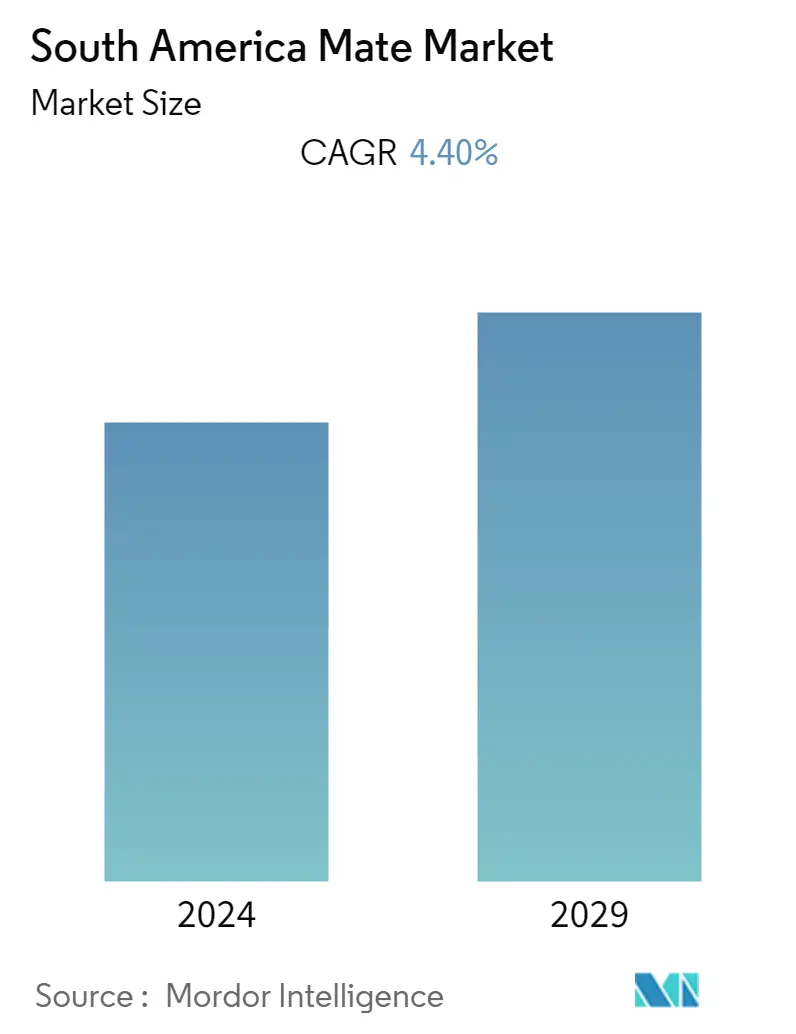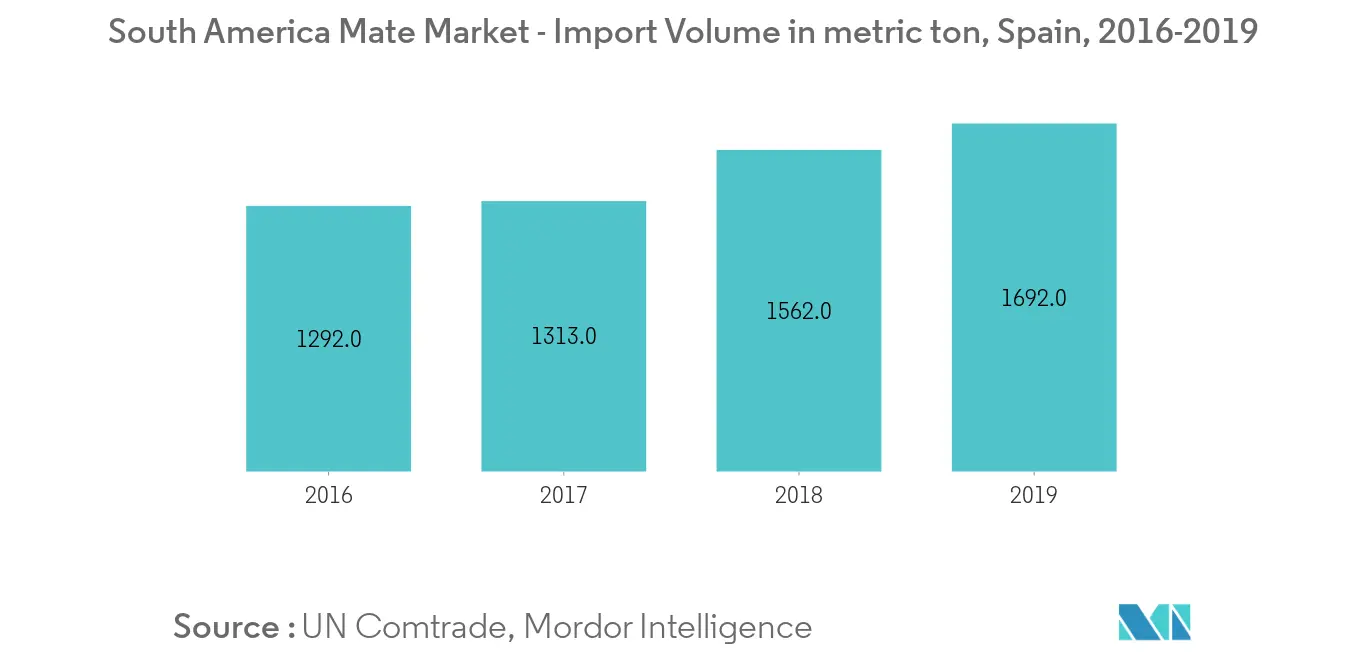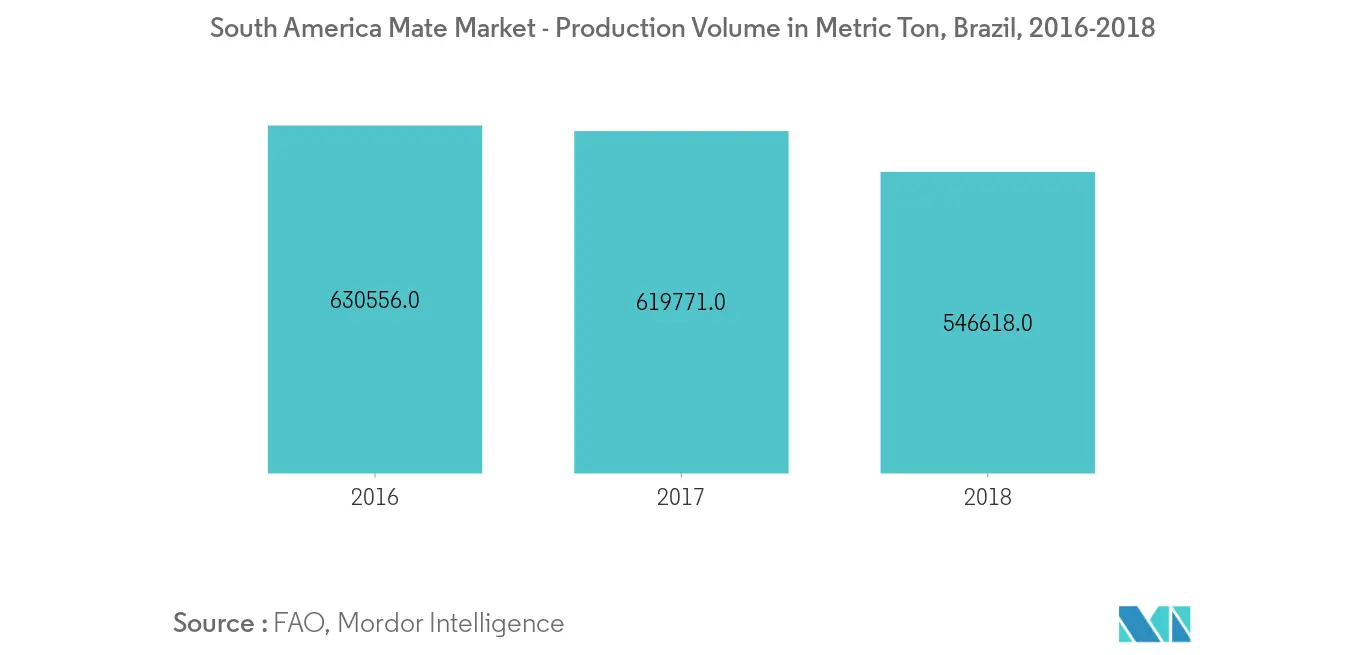South America Mate Market Size

| Study Period | 2019 - 2029 |
| Base Year For Estimation | 2023 |
| Forecast Data Period | 2024 - 2029 |
| Historical Data Period | 2019 - 2022 |
| CAGR | 4.40 % |
Major Players*Disclaimer: Major Players sorted in no particular order |
South America Mate Market Analysis
The Mate market in South America is estimated to grow at a CAGR of 4.4% during the forecast period (2020 - 2025).
Emerging export potential for the North American and European markets along with a stabilized demand from Syria and Chile, and a revival in the regional domestic demand, have given a boost to the yerba mate market in South America, in recent years. Furthermore, the development of several initiatives by INYM, aided by burgeoning demand for the caffeine-induced flavorful beverage as a viable alternative to coffee in the export markets, have acted as a stimulus to the production of mate in the region.
In terms of production, Brazil was the largest market for yerba mate in the region in 2019, followed by Argentina. The country produced a total of 546,618.0 metric tons of yerba mate in 2018. Although the largest producer in the region, Brazil witnessed a diminishing trajectory in product levels as it produced a total of 630.5 thousand metric tons in 2016, which stands in stark contrast to the production level in 2018. The production level in Argentina, on the other hand, has been rising steadily, reaching 302.1 thousand metric ton in 2018.
South America Mate Market Trends
This section covers the major market trends shaping the South America Mate Market according to our research experts:
Emerging Export Potential Driving Production
Burgeoning demand for mate in the United States and European countries, such as France Germany, and Spain, besides Syria and Turkey in the Middle East, has been witnessed in recent years, that can be primarily attributed to the perceived benefits of mate to conventional drinks like tea and coffee. As per studies conducted by the University Cardiology Foundation in Brazil, regular mate consumption has been observed to establish a correlation with increased energy levels, increased antioxidants, and lower cholesterol levels. According to UN Comtrade's statistical database, South America, together with the Caribbean Aggregation, exported a total of 80,411.0 metric tons of mate in 2019, as against 66,093.0 metric tons in 2017. Moreover, the emerging demand in the international markets, especially Europe, is also dominated by a growing inclination towards exotic foreign beverages complementing drinks with added health benefits like no other. For instance, Spain imported 1,313.0 metric tons of mate in 2017, which rose by 28.86% to 1,692.0 metric tons in 2019.

Brazil - The Largest Mate Producing Country
According to the Food and Agriculture Organization's statistics, Brazil produced a total of 546,618.0 metric tons of mate in 2018, as compared to 302,099.0 metric tons in Argentina, during the same year, thus, ranking Brazil as the largest producer of mate in the region as well as globally. However, the production level has declined considerably from 630,556.0 metric tons in 2016, primarily due to the significant fall in the area harvested, which stood at 74,943.0 hectares in 2016, when compared to 71,979.0 hectares in 2018. Due to the sprouting global demand for yerba mate, global giants are eyeing to capitalize on the untapped market space with innovative products sourced from the Brazilian farms. For instance, Coca-Cola Brazil launched its new product range of yerba mate pods under the Leao brand in 2019, with the ingredients sourced specifically from farms in southern Brazil. Such developments are further expected to boost the production of yerba mate in Brazil, in the coming years.

South America Mate Market Report - Table of Contents
1. INTRODUCTION
- 1.1 Study Assumptions & Market Definition
- 1.2 Scope of the Study
2. RESEARCH METHODOLOGY
3. EXECUTIVE SUMMARY
4. MARKET DYNAMICS
- 4.1 Market Overview
- 4.2 Market Drivers
- 4.3 Market Restraints
- 4.4 Value Chain Analysis
5. MARKET SEGMENTATION
-
5.1 Argentina
- 5.1.1 Production Analysis
- 5.1.2 Consumption Analysis & Market Size
- 5.1.3 Import Market Analysis (Volume & Value)
- 5.1.4 Export Market Analysis (Volume & Value)
- 5.1.5 Price Trend Analysis
-
5.2 Brazil
- 5.2.1 Production Analysis
- 5.2.2 Consumption Analysis & Market Size
- 5.2.3 Import Market Analysis (Volume & Value)
- 5.2.4 Export Market Analysis (Volume & Value)
- 5.2.5 Price Trend Analysis
-
5.3 Paraguay
- 5.3.1 Production Analysis
- 5.3.2 Consumption Analysis & Market Size
- 5.3.3 Import Market Analysis (Volume & Value)
- 5.3.4 Export Market Analysis (Volume & Value)
- 5.3.5 Price Trend Analysis
-
5.4 Chile
- 5.4.1 Production Analysis
- 5.4.2 Consumption Analysis & Market Size
- 5.4.3 Import Market Analysis (Volume & Value)
- 5.4.4 Export Market Analysis (Volume & Value)
- 5.4.5 Price Trend Analysis
-
5.5 Uruguay
- 5.5.1 Production Analysis
- 5.5.2 Consumption Analysis & Market Size
- 5.5.3 Import Market Analysis (Volume & Value)
- 5.5.4 Export Market Analysis (Volume & Value)
- 5.5.5 Price Trend Analysis
6. MARKET OPPORTUNITIES & FUTURE TRENDS
7. IMPACT OF COVID-19
** Subject To AvailablitySouth America Mate Industry Segmentation
Yerba mate, also known as chimarrão in Brazil, is a species of the genus, Ilex paraguariensis A. St.-Hil., which is used to make the beverage known as mate. For the purpose of the study, mate with the HS code 0903, as per the UN Comtrade statistical database, has been considered under the scope. The market is segmented into the major countries involved in the production, consumption, and trade of mate in South America, viz., Brazil, Argentina, Paraguay, Chile, and Uruguay. The review period considered for the study is 2016-2019 and the forecast period is 2020-2025.
| Argentina | Production Analysis |
| Consumption Analysis & Market Size | |
| Import Market Analysis (Volume & Value) | |
| Export Market Analysis (Volume & Value) | |
| Price Trend Analysis | |
| Brazil | Production Analysis |
| Consumption Analysis & Market Size | |
| Import Market Analysis (Volume & Value) | |
| Export Market Analysis (Volume & Value) | |
| Price Trend Analysis | |
| Paraguay | Production Analysis |
| Consumption Analysis & Market Size | |
| Import Market Analysis (Volume & Value) | |
| Export Market Analysis (Volume & Value) | |
| Price Trend Analysis | |
| Chile | Production Analysis |
| Consumption Analysis & Market Size | |
| Import Market Analysis (Volume & Value) | |
| Export Market Analysis (Volume & Value) | |
| Price Trend Analysis | |
| Uruguay | Production Analysis |
| Consumption Analysis & Market Size | |
| Import Market Analysis (Volume & Value) | |
| Export Market Analysis (Volume & Value) | |
| Price Trend Analysis |
South America Mate Market Research FAQs
What is the current South America Mate Market size?
The South America Mate Market is projected to register a CAGR of 4.40% during the forecast period (2024-2029)
What years does this South America Mate Market cover?
The report covers the South America Mate Market historical market size for years: 2019, 2020, 2021, 2022 and 2023. The report also forecasts the South America Mate Market size for years: 2024, 2025, 2026, 2027, 2028 and 2029.
South America Mate Industry Report
Statistics for the 2024 South America Mate market share, size and revenue growth rate, created by Mordor Intelligence™ Industry Reports. South America Mate analysis includes a market forecast outlook 2029 and historical overview. Get a sample of this industry analysis as a free report PDF download.



